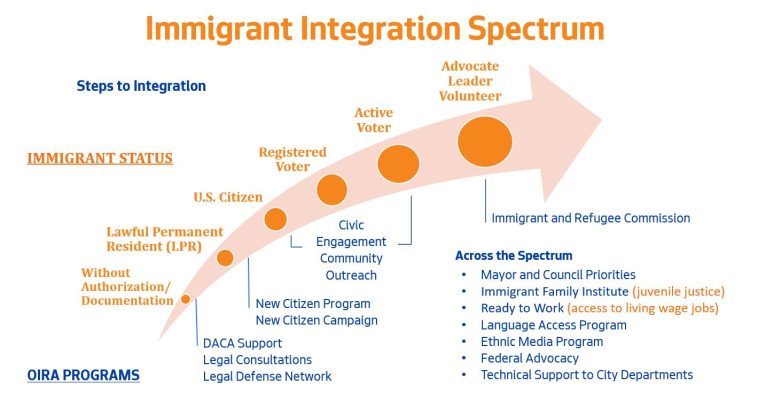
Opinion Editorial: Rethinking Integration Through the Capabilities Approach
The debate about how to genuinely assess immigrant incorporation has been long and full of tricky parts. Traditional measures of integration usually compare immigrants and their descendants to native-born populations using a small set of indicators such as employment, education, and political participation. However, these comparisons often miss the tangled issues that influence a person’s overall quality of life. In today’s increasingly diverse societies, it is time we take a closer look at human flourishing rather than simply focusing on becoming like those who have historically lived in a place.
This opinion piece offers a perspective that moves away from rigid group comparisons to a more inclusive evaluation of quality of life through the capabilities approach. Drawing on recent research and real-world examples, we will explore how a capabilities-based framework can address hidden complexities in immigrant life, while also illuminating the key differences between integration policies shaped by old paradigms and a framework that promotes general human flourishing.
Challenging the Old Integration Paradigm
For decades, integration studies have focused on small sets of indicators such as employment rates, educational attainment, housing status, and political engagement. Although useful in some respects, these measures often reduce the immigrant experience to a set of numbers. They fail to capture the subtle parts of human well-being, such as emotional health, family bonds, or even the fear and anxiety experienced in public spaces.
Traditional integration paradigms are built on the premise that immigrants should eventually become more similar to natives. That means success is often measured by how well immigrants can blend into an existing social fabric. In doing so, these measures may overlook the nerve-racking and overwhelming issues that are imposed by policies anchored in nationalism and even colonial legacies.
Critics argue that such an approach is on edge with political and social implications, as it implicitly labels differences as deficiencies. The result is a system that is too rigid to deal with the fine points and subtle details of a person’s lived experience. Instead of valuing the unique contributions immigrants bring to society, the conventional integration model pressures them to conform to a pre-established standard.
Key Issues in Traditional Integration Assessments
- Limited Indicators: Standard assessments typically focus on employment, education, social inclusion, health, and political participation.
- Group Comparisons: Immigrants and their descendants are often compared directly with native born citizens, ignoring individual differences.
- Overlooking Hidden Complexities: Factors like family networks, emotional well-being, and the impacts of discrimination are treated as secondary or not measured at all.
These points highlight the need to move beyond a single-minded focus on making immigrants “like natives” and instead to concentrate on how every individual can lead a thriving life in all its facets.
Understanding the Capabilities Approach
The capabilities approach offers a promising alternative. Instead of merely gauging the possession of certain attributes, the capabilities framework dives into what individuals are actually able to do and be. In plain terms, it looks at whether people have the freedom and opportunity to enjoy a full quality of life. This is not simply a tally of achievements but an evaluation of the overall conditions that allow a person to flourish.
Originating from the thinkers Amartya Sen and Martha Nussbaum, the capabilities approach is grounded in the idea that every human being has a set of fundamental capacities. These include cognitive, emotional, physical, and social abilities which must be nurtured so that each person can lead a life they find valuable. Unlike the integration paradigm, which tends to focus on short-term outputs and comparisons, the capabilities approach aims for long-term human flourishing and social justice.
Core Components of the Capabilities Framework
A capabilities assessment considers a wide range of factors that are key to a meaningful life, including:
- Family and Social Networks: The quality of relationships and access to supportive networks can make a huge difference in personal and professional success.
- Emotional and Psychological Well-Being: Being able to express feelings and manage stress is super important for overall mental health.
- Bodily Integrity and Health: Access to reliable health care, freedom from violence, and the ability to feel safe in public spaces are essential capabilities.
- Control Over One’s Environment: This includes the freedom to participate in community life, engage politically, and shape one’s surroundings.
- Educational and Skill Development: Fostering abilities and ensuring access to education are central to personal development.
The important twist here is that the capabilities approach does not force a one-size-fits-all comparison. Instead, it emphasizes an absolute assessment of what every member of society needs to thrive, regardless of their background. By steering through this approach, policymakers have the chance to improve quality of life for everyone, rather than targeting only one segment of society in a comparative manner.
Addressing Discrimination and Exclusion
One of the most tangled issues for immigrants is discrimination. Despite being deemed “well integrated” by traditional measures—such as holding a good job, having a university degree, and participating in community activities—many immigrants continue to face discrimination in more subtle, yet impactful ways. These issues do not always show up in standard integration surveys, which is why it is essential to take a closer look at quality of life through the capabilities lens.
For example, anecdotal evidence shows that even highly educated individuals with strong employment records often report incidents where their names or appearances lead to biased treatment. Such experiences affect their ability to control their environment and express their emotions freely. These problems are not just “academic” but are real, everyday experiences that can undermine one’s well-being.
Examples of Hidden Discrimination in Daily Life
| Indicator | Traditional Integration Measure | Capabilities Perspective |
|---|---|---|
| Employment | Job status and salary levels | Opportunity for career growth, recognition, and fair treatment regardless of background |
| Housing | Home ownership or access to rental properties | Ability to secure safe, affordable, and welcoming living arrangements without discrimination |
| Social Inclusion | Membership in associations and community groups | Genuine sense of belonging and comfort in public spaces, free from prejudice |
This table underscores that while traditional approaches may tick the boxes, they can miss deep-seated issues like discrimination and the resulting stress that impairs quality of life.
Real-World Voices: Insights from Barcelona
To dive into the practical side of these discussions, consider the experiences of individuals who grew up in Barcelona with immigrant backgrounds. Their life stories demonstrate that an assessment based solely on integration indicators might paint an overly simplistic picture of success while hiding nerve-racking and overwhelming realities.
Case Studies: Comparing Integration and Capabilities Outcomes
Let’s take a closer look at three hypothetical yet representative profiles:
- Said: A 29-year-old man of Moroccan descent, born in Barcelona and holding a stable job with a good salary. Traditional measures rate him as well integrated. However, when asked about his capabilities, he revealed that bureaucratic delays in obtaining legal documents and the fear of racist violence on public transportation heavily impact his ability to enjoy family life and move freely in his city.
- Xiaoyan: A 33-year-old woman of Chinese heritage, who holds a university degree and a stable job while owning her home. Although she meets traditional integration benchmarks, Xiaoyan shared that the lack of political participation due to citizenship restrictions and ongoing racial discrimination at work diminishes her sense of control over her environment and overall well-being.
- Shazia: A 30-year-old woman of Pakistani origin, growing up in Barcelona and succeeding academically and professionally. Despite these achievements, her capabilities assessment uncovers that she experiences obstacles related to inadequate private space and overt instances of discriminatory behavior when seeking rental accommodations, which further limits her family prospects.
These stories illustrate that while standard indicators may label these individuals as “successfully integrated,” a more detailed capabilities analysis exposes the nerve-racking challenges they continue to face. The complexities of discrimination, limited emotional expression, and restricted control over personal environments make plain that there is more to integration than meets the eye.
Policy Implications: Steering Toward Human Flourishing
The discussion above sets the stage for a pivotal policy re-evaluation. Rather than receiving policies that focus solely on narrow metrics—such as the rate of employment or home ownership—policymakers should consider a broader, more human-centered evaluation. This means designing strategies that help every individual, regardless of migration background, enhance their capabilities and overall quality of life.
Reforming Policies with a Capabilities Focus
When rethinking policies, it is important to consider:
- Inclusive Social Services: Expand the reach of social programs to address emotional well-being, mental health, and social inclusion beyond standard health check-ups.
- Fair Housing Opportunities: Establish measures that protect individuals from discriminatory practices and ensure equal access to quality housing.
- Political Empowerment: Reform citizenship policies that limit political participation and create inclusive channels for civic engagement.
- Workplace Equality: Implement anti-discrimination trainings and support mechanisms within industries to ensure that all employees, regardless of background, can thrive without fear of bias.
These policy changes would not only address the immediate, tricky parts of immigrant incorporation but also steer society toward more just and flexible frameworks that promote overall human flourishing. In this way, the approach shifts from trying to “fix” immigrants to enhancing the opportunities and capabilities of everyone living in the society.
Overcoming Measurement Challenges and Fine-Tuning the Approach
One of the nerve-racking challenges in embracing the capabilities approach is creating reliable measurement tools that capture the full picture of human well-being. Unlike the straightforward metrics used in the integration paradigm, assessing capabilities demands the design of more comprehensive instruments that consider both tangible and intangible qualities of life.
The Nitty-Gritty of Measuring Capabilities
Here are some essential details that researchers and policymakers need to consider when picturing a capabilities-based assessment:
- Customized Indicators: Develop context-specific indicators that relate directly to the local culture and socioeconomic conditions rather than using a one-size-fits-all checklist.
- Participatory Methods: Engage community members in shaping the list of capabilities that matter most. This way, the final tool is rooted in the lived experiences of those it is meant to serve.
- Longitudinal Studies: Instead of snapshot assessments, implement studies that track how individuals’ capabilities change over time, giving a more dynamic view of human flourishing.
- Mixed-Methods Approaches: Combine quantitative surveys with qualitative interviews to capture both the numbers and the hidden complexities behind them.
Although these tasks may feel intimidating and even overwhelming at first, they are essential steps in creating a framework that truly reflects the human experience of integration. Implementing such tools will require close collaboration between researchers, government agencies, and community organizations.
Social and Cultural Dimensions: The Human Side of Integration
It is important not to overlook the cultural and social elements that contribute to quality of life. Integration is not simply about meeting economic targets; it is also about creating environments where people feel welcomed, respected, and empowered. The capabilities approach acknowledges that even when traditional markers are met, the little twists and subtle details of everyday experience can make all the difference.
Building a Society That Values Every Individual
A healthy society is one where every member, regardless of origin, feels that their unique contributions are recognized. This means acknowledging not only academic or economic achievements but also the value of diverse cultural expressions. For immigrants, culturally sensitive policies and programming can help build bridges between different communities and reduce the racialized, off-putting gaps that often lead to exclusion.
Examples of such measures could include:
- Cultural Competency Training: For educators, law enforcement, and public service employees, helping them understand the diverse backgrounds of the communities they serve.
- Community Engagement Programs: Initiatives that invite both immigrants and native-born citizens to participate in cultural exchanges and community-building activities.
- Language and Diversity Initiatives: Programs that encourage multilingualism and the celebration of cultural heritage as essential parts of the national narrative.
These efforts, embedded in a capabilities framework, can help reduce the nerve-racking experiences of discrimination and improve each individual’s sense of belonging and control over their environment.
Moving Forward: Finding Your Path Through Complex Policy Terrain
While the capabilities approach provides a promising alternative to traditional integration paradigms, implementing it is not without its own set of challenges. Researchers and policymakers must work together to figure a path through the overwhelming and often complicated pieces of human subjectivity that are important to measure.
Key Steps for Future Research and Policy Design
Drawing from existing studies and the experiences of immigrant communities, the following steps can help guide future endeavors:
- Collaborative Tool Development: Bring together academic experts, community leaders, and policymakers to design tools that accurately assess capabilities.
- Community Participation in Evaluation: Ensure that the voices of immigrants and their descendants have a central role in shaping what matters most in quality-of-life assessments.
- Expand Beyond National Borders: Acknowledge that many immigrants live in a globalized world where comparisons should not be limited by rigid national categories.
- Policy Experimentation: Encourage pilot programs that apply the capabilities framework in local communities to see real outcomes, refining methods as needed.
These steps are critical if we are to move beyond a system that is loaded with issues and biases to one that truly supports human flourishing for all members of society.
Reflecting on the Bigger Picture
At its core, the shift from the traditional integration model to a capabilities approach is about rethinking what it means to belong and thrive in a multicultural society. Instead of seeing integration as an end goal where immigrants must achieve a narrow and pre-defined set of attributes, the focus shifts to nurturing the overall quality of life for every individual.
This not only captures the tangles and twists of everyday experiences but also validates the spirit of human diversity. It offers a clear message to those working in government, academia, and community organizations: Policies should aim to uplift every individual’s potential without forcing them to conform to a limited view of success.
By taking a closer look at capabilities, we can recognize that the conditions necessary for a fulfilling life are not the same for everyone. They are influenced by a host of factors including family support, emotional well-being, the freedom to participate in society, and the ability to feel safe and respected. Ultimately, this approach calls for more intuitive, flexible, and human-centered policies that work through the small details that matter the most.
Conclusion: Embracing Human Flourishing as the Ultimate Goal
In wrapping up, the discussion on rethinking integration from the perspective of the capabilities approach reminds us that the goal of any immigrant-receiving society should be to foster an environment where every individual has the opportunity to flourish. Traditional integration metrics can tell part of the story, but they often miss the hidden complexities and nerve-racking challenges that many immigrants face on a daily basis.
When we figure a path from statistical comparisons to an absolute evaluation of quality of life, policies can shift from simply checking boxes to truly empowering communities. The capabilities approach offers a super important framework that values the full spectrum of human potential. By focusing on what people are truly able to do and be, it provides a nuanced understanding of social inclusion—one that holds promise for creating societies where everyone feels valued, safe, and empowered.
Though transitioning to this framework may seem intimidating, the potential benefits of a society designed around human flourishing are enormous. It is a call to move beyond the limited indicators of old and to embrace policies that encourage every individual to thrive. As we continue to witness rapid demographic shifts and increasingly tangled social dynamics in cities around the world, now is the time to take a closer look at the capabilities approach as a pathway toward a more inclusive, fair, and vibrant society for all.
Originally Post From https://comparativemigrationstudies.springeropen.com/articles/10.1186/s40878-025-00495-3
Read more about this topic at
Adapt, Align, Redefine your Integration
What does Integration Capability mean and how to develop it?


